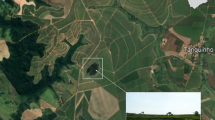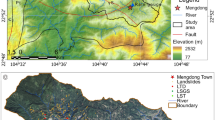Abstract
Based on the data from piezometers, well logs, geophysical surveys and the interferometric synthetic aperture radar (InSAR) technique, this study investigates the main causes of land subsidence in Damaneh City, Iran. The size, openings and direction of fissures were measured by micrometer and compass. The locations of fissures and wall cracks were determined by GPS. The geoelectrical data were used to determine the composition, thickness, depth and shape of lower parts of the aquifer. Groundwater fluctuations were evaluated by available piezometers. The InSAR technique was used to measure land deformation from space and to map the dense changes of surface displacements. The results indicate that the main cause of ground subsidence is the decline of groundwater heads and changes in composition and thickness of compressible lacustrine sediments. The subsidence map obtained from the radar data of ASAR sensor of ENVISAT satellite shows that the subsidence zone is mainly in northern city that is underlain by very thick fine sediments. The subsidence rates from March to December 2005 and from July 2011 to January 2012 are 6.7 and 7.0 cm/a, respectively. The results also show good correlations among the formation of earth features, decline in groundwater head and thickness of fine-grained sediments. We recommend that the groundwater withdrawal for agricultural and industrial sectors should be restricted and urban expansion in the northern part of the city should be constrained.
Similar content being viewed by others
References
Adiyaman I B. 2012. Land subsidence and earth fissures due to groundwater pumping. PhD Dissertation. Tucson: University of Arizona.
Bates R L, Jackson J A. 1980. Glossary of Geology (2nd ed.). Falls Church, Virginia: American Geological Institute, 749.
Bell F G. 1999. Geological Hazards: Their Assessment, Avoidance and Mitigation. London: E and FN Spon.
Bell J W, Price J G. 1991. Subsidence in Las Vegas Valley, 1980–91-final project report. Reno: Nevada Bureau of Mines and Geology.
Bell J W, Amelung F, Ramelli A R, et al. 2002. Land subsidence in Las Vegas, Nevada, 1935–2000: new geodetic data show evolution, revised spatial patterns, and reduced rates. Environmental and Engineering Geoscience, 8(3): 155–174.
Bonì R, Herrera G, Meisina C, et al. 2015. Twenty-year advanced DInSAR analysis of severe land subsidence: the Alto Guadalentín Basin (Spain) case study. Engineering Geology, 198: 40–52.
Bouwer H. 1977. Land subsidence and cracking due to ground-water depletion. Ground Water, 15(5): 358–364.
Burbey T J. 2002. The influence of faults in basin-fill deposits on land subsidence, Las Vegas Valley, Nevada, USA. Hydrogeology Journal, 10(5): 525–538.
Carruth R L, Pool D R, Anderson C E. 2007. Land subsidence and aquifer-system compaction in the Tucson Active Management Area, south-central Arizona, 1987–2005. Reston, Va.: U.S. Department of the Interior, U.S. Geological Survey, 27.
Chatterjee R S, Fruneau B, Rudant J P, et al. 2006. Subsidence of Kolkata (Calcutta) City, India during the 1990s as observed from space by Differential Synthetic Aperture Radar Interferometry (D-InSAR) technique. Remote Sensing of Environment, 102(1–2): 176–185.
Esmaili M, Motagh M. 2009. Remote sensing measurements of land subsidence in Kerman valley, Iran, 2003–2009. In: American Geophysical Union, Fall Meeting 2009, Abstract, NH43C-1348.
Freyre D C, Cerca M, Marin M H. 2003. Propagation of fracturing related to land subsidence in the valley of Queretaro, Mexico. In: Multidisciplinary Studies of Land Subsidence and Regional Fracturing in Fluvio-Lacustrin Basons. Puerto Vallarta, Mexico, 2.
Galloway D L, Ingebritsen S E, Riley F S, et al. 1999. The role of science. In: Galloway D L, Jones D R, Ingebritsen S E. Land Subsidence in the United States: U.S. Geological Survey Circular. [S.l.]: U.S. Geological Survey, 1182: 141–158.
Galloway D L, Jones D R, Ingebristen S E. 2000. Ground water resources for the future US U.S. Geological Survey Fact Sheet-165-, 4.
Galloway D L, Hoffmann J. 2007. The application of satellite differential SAR interferometry-derived ground displacements in hydrogeology. Hydrogeology Journal, 15(1): 133–154.
Galloway D L, Burbey T J. 2011. Review: regional land subsidence accompanying groundwater extraction. Hydrogeology Journal, 19(8): 1459–1486.
Ghazifard A, Moslehi A, Safaei H, et al. 2016. Effects of groundwater withdrawal on land subsidence in Kashan Plain, Iran. Bulletin of Engineering Geology and the Environment, 75(3): 1157–1168, doi: 10.1007/s10064-016-0885-3.
Helm D C. 1994. Hydraulic forces that play a role in generating fissures at depth. Bulletin Association Engineering Geologists, 31(3): 293–304.
Hoffmann J, Zebker H A, Galloway D L, et al. 2001. Seasonal subsidence and rebound in Las Vegas Valley, Nevada, observed by synthetic aperture radar interferometry. Water Resources Research, 37(6): 1551–1566.
Holzer T L, Galloway D L. 2005. Impacts of land subsidence caused by withdrawal of underground fluids in the United States. Geological Society of America: Reviews in Engineering Geology, 16(303): 87–99.
Hou C S, Hu J C, Shen L C, et al. 2005. Estimation of subsidence using GPS measurements, and related hazard: the Pingtung Plain, southwestern Taiwan. Comptes Rendus Geoscience, 337(13): 1184–1193.
Liu D L, Shao Y F, Liu Z G, et al. 2014. Evaluation of InSAR and TomoSAR for monitoring deformations caused by mining in a mountainous area with high resolution satellite-based SAR. Remote Sensing, 6(2): 1476–1495.
Lubis A M, Sato T, Tomiyama N, et al. 2011. Ground subsidence in Semarang-Indonesia investigated by ALOS-PALSAR satellite SAR interferometry. Journal of Asian Earth Sciences, 40(5): 1079–1088.
Massonnet D, Feigl K L. 1998. Radar interferometry and its application to changes in the earth surface. Reviews of Geophysics, 36(4): 441–500.
Ortega-Guerrero A, Rudolph D L, Cherry J A. 1999. The analysis of long-term land subsidence near Mexico City: field investigations and predictive modeling. Water Resources Research, 35(11): 3327–3341.
Phien-Wej N, Giao P H, Nutalaya P. 2006. Land subsidence in Bangkok, Thailand. Engineering Geology, 82(4): 187–201.
Pope J P, Burbey T J. 2004. Multiple-aquifer characterization from single borehole extensometer records. Ground Water, 42(1): 45–58.
Raucoules D, Colesanti C, Carnec C. 2007. Use of SAR interferometry for detecting and assessing ground subsidence. Comptes Rendus Geoscience, 339(5): 289–302.
Rosen P A, Hensley S, Peltzer G, et al. 2004. Updated repeat orbit interferometry package released. EOS, Transactions American Geophysical Union, 85(5): 47.
Saracin A, Cosarca C, Didulescu C, et al. 2014. Using InSAR technology for monitoring vertical deformation of the earth surface. Advances in environmental development, geomatics engineering and tourism. In: Proceedings of the 2nd European Conference of Geodesy and Geomatics Engineering (GENG 14). Brasov, Romania: GENG, 41–48.
Sharifikia M. 2009. D-InSAR data processing and analysis for mapping land subsidence phenomenon in Rafsanjan area. Thesis. Submitted to Andra University-India.
Sheng Z P, Helm D C, Li J. 2003. Mechanisms of earth fissuring caused by groundwater withdrawal. Environmental and Engineering Geoscience, 9(4): 351–362.
Sneed M, Galloway D L. 2000. Aquifer-system compaction and land subsidence: measurements, analyses, and simulations-the Holly Site, Edwards Air Force Base, Antelope Valley, California. USGS.
Wang G Y, You G, Shi B, et al. 2009. Long-term land subsidence and strata compression in Changzhou, China. Engineering Geology, 104(1–2): 109–118.
Wei Q L. 2006. Land subsidence and water management in Shanghai. MSc Thesis. Delft: Delft University.
Acknowledgments
This research was conducted in department of geology at the University of Isfahan. The authors would like to thank the European Space Agency (ESA) for providing SAR images (ENVISAT data).
Author information
Authors and Affiliations
Corresponding author
Rights and permissions
About this article
Cite this article
Ghazifard, A., Akbari, E., Shirani, K. et al. Evaluating land subsidence by field survey and D-InSAR technique in Damaneh City, Iran. J. Arid Land 9, 778–789 (2017). https://doi.org/10.1007/s40333-017-0104-5
Received:
Revised:
Accepted:
Published:
Issue Date:
DOI: https://doi.org/10.1007/s40333-017-0104-5




